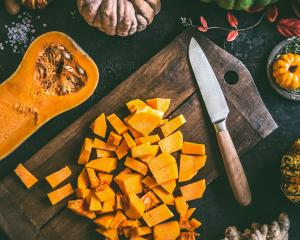Food waste is a hot topic these days. Food thrown out rather than eaten is not only a waste of money but also of the resources and energy used in its production and distribution and it contributes to landfill which is bad for the planet.
But what role do supermarkets play in this? asks Charmian Smith.
Until recently no-one knew how much food supermarkets wasted.
Five or six years ago, when food recovery organisations were getting started, they initially found it was difficult to get supermarkets on board and academics trying to research the topic came up against a brick wall.
‘‘I remember the discourse at the time — ‘We don’t waste food’ — they wouldn’t even admit to having food waste,’’ Associate Prof Miranda Mirosa, of the University of Otago’s food science department, said.
Some films, including one about dumpster divers rescuing edible food from supermarket skips, exposed the issue and gave the industry a shake-up, she said.
The 2014 Food Act immunity for food donors clause made it possible for firms to donate food in good faith without the risk of being liable for any illness caused subsequently, which allows still edible food to be donated to charity.
There were no New Zealand figures for retail food waste until Prof Mirosa and Prof Sheila Skeaff, of the university’s human nutrition department, supervised research on the topic by master’s degree student Francesca Goodman-Smith, who is now waste minimisation manager for Foodstuffs. It was challenging research because of the competition between two supermarket chains. They had to sign all sorts of confidentiality agreements, they said.
Interestingly, Goodman-Smith’s research found supermarkets send about 3kg of food per person per year to landfill compared with consumers, who send almost 10 times as much — 29kg per person per year, Prof Mirosa said.
While they were doing fairly well in comparison, there were still unacceptable amounts of food going to waste and lots of room for improvement, she said.
Until recently, it was thought that in developed countries consumers were the main wasters of food, but recent Australian figures revealed there was also a large amount of wastage during production and there was no reason to think New Zealand would be much different.
The project studied 16 supermarkets, four in each of the main centres, and found that 15% of their waste was diverted to foodbanks, 15% went to protein reprocessing, 40% went to animal feed, 1% to compost and 23% to landfill. Of the food going to landfill, 23% was dairy, 23% bakery and 21% meat and fish — this was what they were most concerned about, according to Prof Mirosa.
When the floods in December last year prevented trucks getting south, supermarket shelves quickly emptied.
Retailers responded to what consumers wanted, so if they believed people were happy with running down stock or buying imperfect fruit or vegetables and there was enough consumer pressure, it would be in their interests to do so, she said.
Many supermarkets were now helping consumers reduce their own waste by educating shoppers, giving information about storage and use of fresh produce such as how avocados change colour as they ripen, or what to do with bananas that are starting to get brown spots on their skin or selling imperfect produce cheaply.
Prof Skeaff pointed out that if people wasted less food in the home they would be buying less, but it was all part of valuing the food we buy.
‘‘We also have this attitude that we expect things to be very cheap, and of course people are on budgets, so it’s finding the happy medium.’’
Overseas research showed that for every $1 spent on food waste reduction, the retailer could realise $5-$10.
However, the main problem with reducing waste in supermarkets was lack of staff training about what was edible or not, and the time it took to sort the products, according to Goodman-Smith’s research.
One supermarket manager said: ‘‘We’d like to do more but it’s time, it’s space, it’s time pressures, more processes added to our current processes — there’s too much work and it needs to be easy.’’
Items removed from shelves were put at the back of the store and had to be sorted into diversion options.
‘‘One of the supermarkets had a test which back-of-store staff who are not always highly trained had to apply — Would I eat it? But that, of course, is highly subjective and everyone has different thresholds and ability,’’ Prof Mirosa said.
If considered edible, it went to food recovery if there was an appropriate operation.
Some producers required any unsold product to be removed from the shelves a couple of days before its use-by date and returned rather than be diverted to charity. It was a complex issue, Prof Mirosa said.
‘‘It was quite heartbreaking going through this waste and seeing this pile going somewhere else — and inevitably it will go to landfill because it’s not intended that this produce is going to be recovered — these organic milks and beautiful produce. Often, they weren’t even up to their best-before date.’’













